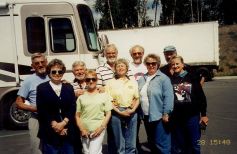June 1998
<<<
Monday, 1 June 1998
Tuesday, 2 June 1998
Continuing our northwesterly route we arrived in Fort
Nelson after a journey of 280 miles, where we stayed two nights. For the
most part, the terrain was gradual inclines and descents and almost endless
forests partly relieved by the sight of an occasional mouse, elk or deer. We are
told that there are a lot of bears in the area but so far we have not seen any.
Sixty miles from Fort Nelson, Leo’s RV developed a leak, losing all its
hydraulic fluid. Considering our isolated location we were surprised that a tow
truck arrived within 90 minutes.
Wednesday, 3 June 1998
The leak was traced to a split hose and was repaired by lunchtime however Leo
has lost confidence in his $170,000 RV, as he has so far experienced 18
breakdowns since he purchased it last 0ctober and may decide not to continue to
Alaska. He will decide tomorrow. George developed a bad back and
prevented using the free day to clean the car and RV, which are now covered in
thick dust and mud. We understand that this will be a problem throughout our
Alaskan journey due to the dust and numerous road constructions
Thursday, 4 June 1998
|
Having complained to the RV manufacturer, who
wanted time to investigate, Leo decided to wait
in Fort Nelson for the response. The rest
of us drove to Muncho
Lake which is about 130 miles to the
northwest. On route, we encountered miles of
construction which is an ongoing event every
summer to keep the highway in a road-worthy
condition. This only added to the now filthy
condition of the cars and RVs.
We are camped at the edge of a large
turquoise-coloured lake surrounded by the
Rocky Mountains
and part of a huge Provincial Park. We are the
only ones here. In the evening we took an hours
boat tour where we learned a lot about living in
the very remote area, after which we enjoyed a
campfire and hot dogs for supper. The only
drawback to this idyllic spot is the swarms of
flying insects including huge mosquitoes!
Neither of us has seen so many flying insects
which constantly hover in dense clouds.
Mosquitoes can be such a problem that one of the
construction workers repairing the road had an
anti-mosquito coil permanently attached to the
top of her hard hat!
|
|
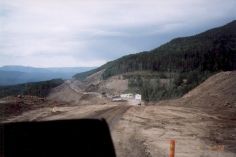
|
|
|
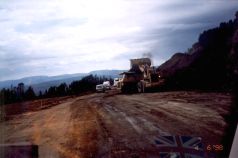
|
|
|
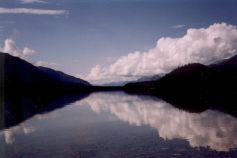
|
Friday, 05 June 1998
|
A very quiet day enjoying the view of the lake
and mountains, watching Stirling and Marianne
attempting to catch some fish, Sam repairing his
RV and in the evening savouring Stirling’s
freshly cooked fish patties as we sat around the
campfire. Some months ago Stirling said he
always grew a beard when going to Alaska
and suggested all the men did the same, which
they have. A daily discussion point is about
whose beard looks the best. It’s George’s first
beard which initially Valerie disliked but has
come to, well almost like.
|
|
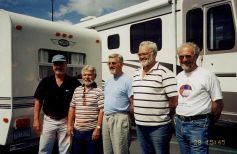
|
Saturday, 6 June 1998
|
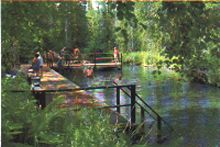
|
|
It was only 36 miles to the
Liard River hot
springs so we arrived by mid-morning and were
all soon making the most of the spring. Unlike
many hot springs which have been covered by
buildings, the Liard spring has been left as a
natural river out in the open. The water
temperature changes from pleasant to very hot by
moving upstream closer to the source. It was all
very pleasant and only spoilt by the mosquitoes
and black flies which appear to enjoy Valerie’s
legs and George’s ankles.
|
Sunday, 7 June 1998
|
Most of the 129 miles to
Watson Lake took us through
continuous forests of relatively small spruce
trees. Due to the short summer trees grow very
slowly but can live for over 100 years. For the
tourist, Watson Lake is probably famous
for the 30,000 or so road signs and car number
plates which have been left by passing visitors
over many years. They are displayed outside a
museum which depicted the conditions in which
the Alaskan Highway builders had to work.
Amongst the thousands of plates from the USA, we
found several from England and many from Europe.
|
|
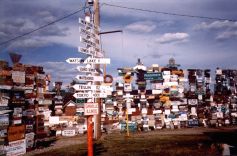
|
Monday, 8 June 1998
The weather was very hot which is unusual for the area but since the water was
available, we washed some of the mud from the RV knowing only too well that it
would not remain clean very long. During the afternoon we all visited a
specially built theatre to see a presentation about the Northern Lights which
covered not only the fables but also the scientific explanation, which was far
less romantic than the fables
Tuesday, 9 June 1998
Today it was through more vast areas of forest, with wildflowers along the
roadside as well as numerous rivers and lakes as we travelled the 166 miles to
Teslin Lake. We saw some Dall Sheep along the
roadside, eating the salt left over from the winter's road snow clearance
activities. Teslin was originally a base for the indigenous Tlingit (say
clingit) Indians who made a livelihood from trapping and selling skins to the
Russians, calling into ports on the far side of the mountains. Upon visiting the
local museum we learned that the building of the Alaskan highway had a
devastating impact on the Indians. In particular with no natural resistance to
measles and similar diseases many died having caught diseases from the tens of
thousands of service personnel who had recently arrived in the area.
Much of northwest Canada and Alaska is a wilderness and well beyond the
limits of the national power grid so each community normally generates its
electricity, which makes it expensive. The nearest doctor can be fifty miles
away and may only visit the local surgery once a month. There are few roads and
communities tend to be small and widely dispersed. Goods are more expensive due
to high transportation costs and shops tend to have a limited selection
available.
Wednesday, 10 June 1998
As we were preparing to depart we were surprised when Leo and Barbara drove into
the campground. It turns out that their RV had been repaired and they were
rejoining our caravan to Alaska. The 120-mile drive to
Atlin included a 40-mile stretch of gravel road which was being
re-graded in several places. As a consequence, the RV’s and cars arrived at the
Norseman RV park fully covered in mud and Leo’s car received numerous dents and
a cracked windshield from the flying stones.
We have an excellent view of the lake, several islands and the glacier mountains
from our RV. Two float planes are moored at the water's edge which during the
afternoon taxied out and took off across the water to fly provisions to a fish
camp out in the wilderness. In the bright sunshine after our evening meal, we
explored the local roads and soon found the remains of what was a prosperous
1890 gold mining town, which at its peak had a population of 10,000. Today a few
miners rework the residue, searching for placer gold, apparently making a
reasonable living. While walking along the edge of
Surprise Lake, Bill pointed out numerous bear droppings so we all
quickly returned to the car.
Thursday, 11 June 1998
|
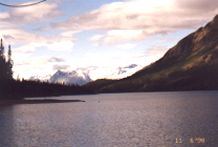
|
|
The campground rented out houseboats so we
arranged to charter one for half a day from the
owner, who took us out to see more of
Atlin Lake, the
glaciers and for a little fishing. As it turned
out the fishing was disappointing but this was
more than made up when we first saw some
mountain goats and then shortly afterwards a
black bear ambling along the deserted shoreline.
It was a large male foraging for food and even
at our safe distance, one could not fail to be
impressed by its size and power.
|
|
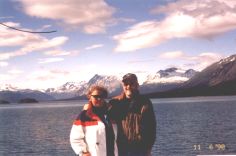
|
|
|
|
|
|
|
We are getting used to seeing lots of beautiful
scenery but we found the view of the
glacier-covered mountains to be delightful.
|
|
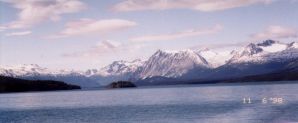
|
Friday, 12 June 1998
|
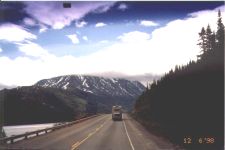
|
|
Atlin
lies at the end of the road so we had to
backtrack but this time as the re-grading was
finished, we encountered far less dust and mud.
After passing through
Carcross the road follows the edge of
Lake Tutshi for
some distance. We then climbed to over 3,200
feet and above the snow line passing through
Tortured Valley
and its desolate barren terrain.
|
|
Shortly afterwards we crossed into Alaska
accompanied by the cheerful refrain of "Attaska,
Attaska we are in Alaska" from Barbara over the
CB. Alaska has its time zone so we put
our clocks back yet another hour making local
time now 9 hours behind England. The
Klondike Highway
descent into Skagway
was long and steep and as we were to later
learn, it was the same back-breaking mountain
that the gold rush miners had climbed in 1898,
on their way to the Klondike gold fields.
|
|
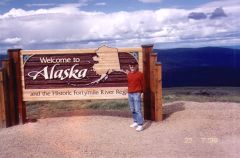
|
Saturday, 13 June 1998
|
Today Skagway is a delightful small town
of 800 lying at the northern end of the
Inside Passage
and provides one of the few sea access points to
the Yukon interior. However, when the
town first appeared almost overnight with the
advent of the Klondike gold rush, it was
a lawless and rough area. It was only when we
visited the local museum did we learn about the
difficulties and hardships the hopeful
prospectors had to endure. To reach the gold
fields each person had to purchase and carry up
through the 3,292-foot mountain pass, enough
food and services to last them a year, which
weighed some 2,000 pounds or they would be
turned back by the Canadian Mounted Police.
|
|
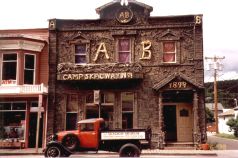
|
|
Once in Canada they then had a further 600 miles
of rivers and lakes to traverse to reach
Dawson City and
then hopefully find enough gold to get rich.
Apparently in the peak year of 1898 thousands of
prospectors formed a continuous line up the side
of the mountain, either carrying their heavy
burden on their backs or the few that could
afford it using dogs or horses. In the evening
Valerie squandered 2,000 dollars (pretend money)
gambling before watching a very enjoyable
theatre show about Soapy Smith, Skagway’s 1898
notorious villain.
|
Sunday, 14 June 1998
|
With Bill and Bev we flew in a six-seat plane to
Juneau which is the
capital of Alaska. Most surprisingly,
Juneau has no road connection to the outside
world so access is only possible by boat or
plane. We flew below the cloud level which was
less than 2,000 feet so we had a close view of
numerous islands and several glaciers. After
picking up a rented car at the airport we had an
interesting tour of the capital building and
state museum. Alaska’s land mass is huge and
with a population of only 800,000, considerable
use is made of video conferencing within the
capital building, so improving communications
and minimising travelling.
|
|
The highlight of our visit to Juneau was
seeing the
Mendenhall Glacier which is 12 miles
long, 1.5 miles wide and over 100 feet thick and
itself an outcrop of a 1,500 square mile ice
field. The huge mass of turquoise ice takes
about 150 years to slide down the mountain
before finally melting into a lake.
|
|
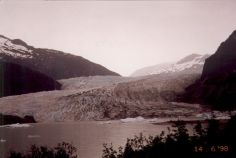
|
Monday, 15 June 1998
Unless we took an expensive ferry the only way out of Skagway was to
backtrack, which concerned Leo as to whether his RV would overheat during the
long steep climb, but all was well. After a long delay at customs crossing back
into Canada, we stopped at Carcross, which was traditionally used as a
water crossing point by thousands of caribou during their migration. After lunch
in the old, strange railroad town we continued to
Whitehorse, arriving just as the rain started.
Tuesday, 16 June 1998
The Yukon which is much larger than England has a
population of 35,000, of which about 20,000 live in Whitehorse, the
capital. Whitehorse was born during the Klondike gold rush when
thousands of prospectors journeyed by ship to Skagway, Alaska, and then
climbed the rugged mountain passes to the headwaters of the
Yukon River. They constructed nearly anything
that would float for the 560-mile trip to Dawson City via Whitehorse,
many dying in the dangerous Whitehorse Rapids.
During the early twentieth century, much of the far north was so remote that
access was only possible by water during the summer. For seven months of the
year the waterways freeze, so once the ice melted in mid-May, the huge boats
were slid back into the water. After being loaded with tons of cargo they set
off on a hazardous journey through the many dangerous rapids and narrows. The SS
Klondike II was one of the largest stern-wheelers on the Yukon River and
typical of the many boats of this kind that operated on the river. The Klondike
II sailed from Whitehorse to the remote Dawson City taking 2.5
days downstream but 5 days to return, due to the fast-flowing water. Before
setting off in the well-preserved boat we watched a fascinating video about
river transport during the 1930s and the hardship involved. What we found
staggering was the vast quantity of wood required to heat the boiler of the
ship, requiring frequent stops on route to load yet more wood. During the
evening Valerie took in a show while George made some bread.
Wednesday, 17 June 1998
|
We are now camped on the edge of
Lake Kluane
overlooking a vast mountain range of the same
name, which has snowy peaks and a large glacier
descending into a valley. This almost
paradise-like location was a 160-mile drive from
Horsebridge
where we now appear to be miles from
civilisation. On route, we saw masses of
wildflowers in every possible colour but
unfortunately no wildlife. A BBQ around the
campfire nicely finished off the day.
|
|
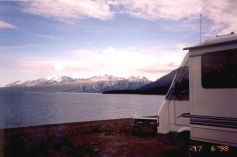
|
|
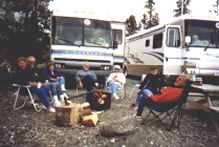
|
Thursday, 18 June 1998
|
t was our turn to lead and we had not travelled
more than 30 miles when we spotted a grizzly
bear eating wildflowers along the roadside. This
caused a flurry of chatter on the CB and the
comment from Vergie that she has already seen
more wildlife during this trip than when they
visited Alaska several years ago. The
rest of the journey was uneventful through more
vast forests but the trees continue to get
smaller due to the shorter growing season. We
stopped overnight in Tok
(rhymes with poke) through which every road
traveller into Alaska needs to pass.
|
|

|
|
It was the first opportunity for a long while to
wash the car so it was given a treat, before us
going out for an outdoor salmon bake in the
bright evening sun. The sun now sets so late
that none of us has seen it set for several
weeks
|
.Friday, 19 June 1998
During our lunch stop on the way to Fairbanks,
we had our first sight of the Trans-Alaska
Pipeline. The 48-inch diameter pipeline is 800 miles long and delivers 2
shiploads of oil a day to the terminal at Valdez.
Since the hot oil could melt the Permafrost (permanently frozen soil) the
pipeline is insulated and supported above ground for about 380 miles. The route
then took us past a vast waterway with silt-laden flats. We stopped at
the North Pole and visited Santa Claus’s home
where every possible Christmas item could be purchased. Bill discovered that his
RV had developed a hydraulic leak, no doubt caused by the constant vibration
from the poor roads. Frost heaves are a major problem as they cause large dips
and distortions in the road and with only a few summer months to carry out
repairs, it is an ongoing battle. Fairbanks is a large town of about 80
thousand so provided an opportunity to stock up on provisions at a more
reasonable price. We decided to camp for several days in Sam’s Club car park.
Saturday, 20 June 1998
A local charity was trying to earn extra cash by washing cars in the car park,
which was an opportunity too good to miss, so we all had our RVs washed.
Leo’s car had developed a problem, which the local garage diagnosed as a slipped
distributor probably caused by road vibration. The drive belt on our RV
continues to slip but so far we have not found anybody who can fix it. As we are
only 200 miles from the Arctic Circle and
today is the summer solstice, the sun does not set until 1.00 am and will rise
at 3.00 am. For the locals, it’s a fun day with special events such as a
midnight golf match and giving away free numbered bananas to obtain a discount
at local stores which stay open until midnight.
Sunday, 21 June 1998
|
Upon arriving at the boat dock we wondered if
there would be enough seats for us since
numerous coaches had already arrived. As it
turned out even with 700 passengers aboard,
there was plenty of room on the stern-wheeler
Discovery III. We initially went downstream on
the River Chena
where at one stage the 250-ton boat was only
clearing the bottom by a few inches. Along the
bank, we saw several beavers and then watched a
bush pilot give a demonstration of a short
take-off by getting airborne from his riverside
garden in less than 100 feet.
|
|
The Chena river joins the wide and
fast-flowing Tanana
River which is the largest glacier-fed
river in the world, whose water is heavily
discoloured with glacier silt sediment. Along
the water's edge, a salmon fishing wheel was in
operation but it did not catch any since the
salmon do not start running upstream until
mid-July. The device is clever since it uses the
power of the flowing water to not only trap the
salmon but also to scoop the fish out of the
water and into a small boat.
We went ashore to visit a replica of a native
Indian village where a dog sledge demonstration
was given by a lady musher. At about 40 lb. the
Husky dogs were surprisingly small considering
the weight pulled and distance travelled. The
dogs love to pull the sledge which may explain
how they travelled 1,200 miles in 11 days in one
of the numerous races held through the winter.
During the afternoon we spent some hours in the
interesting Alaskan University museum which
depicted life in Alaska.
|
|
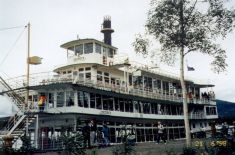
|
|
|
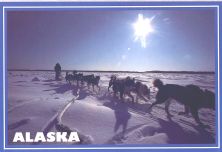
|
.Monday, 22 June 1998
Uneventful day driving the 120 miles to Denali to
visit the wilderness park tomorrow.
Tuesday, 23 June 1998
|
We had a fascinating day. We took the eight-hour
shuttle bus tour into the Denali National
Preserve and Wilderness. The park is vast, with
some 6 million acres which other than the one
96-mile dirt road is completely unchanged by
man. Wildlife lives as nature intended without
any outside intervention.
|
|
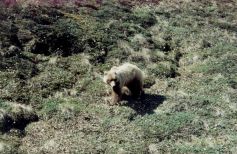
|
|
W Being close to the Arctic Circle the
tree line is at 2,500 feet and the tundra
begins. We saw numerous Alpine wildflowers of
every colour. After an hour and a half of
driving, we were beginning to wonder if was to
be our lucky day, when we rounded a corner and
came across a mother grizzly bear with her
year-old offspring. They were feeding off plants
at the edge of the road and ignored us and we
watched them from no more than twenty feet, so
close in fact that the driver had to close the
bus door.
|
Later we spotted many moose and caribou. On the return trip, we were treated to
a very rare sight when a wolf chased a herd of caribou and took one of the
young. We then saw three grizzlies walking through the tundra and then a mother
grizzly suckling her two young. As we neared the end of the day we spotted a
golden eagle being attacked by a small bird defending its nest. Then an Arctic
fox in its orange coat.
We rounded off the days with a dinner and show, which was a skit about one of
the legendary women who helped open up Alaska at the turn of the century.
Wednesday, 24 June 1998
This is being written at 10 pm and the sun will not set for another one and a
half hours, even then it will not get dark during the night. We drove 240 miles
to Anchorage which with a population of 250, 000
is the largest city in Alaska. For the first 80 or so miles, the snow and
cloud-covered peaks of the Talkeetna Mountains
dominated the view. More vast areas of trees and several wide and fast-flowing
rivers. Alaska has six million rivers, creeks and lakes which were
instrumental in opening up the vast state during the early years. We decided to
camp in the Walmart car park however we were all surprised at how many other RVs
were doing the same. Every shopping area with a reasonable size car park has
RV’s camping overnight. In theory, it is free to camp at Wal-Mart however we all
seem to spend a lot more in the store than staying at a typical campground!
Thursday, 25 June 1998
While we were checking out where Bill and ourselves plan to have some RV service
work carried out we came across a salmon fishing river. Dozens were fishing in
the very fast-flowing Ships Creek, all wearing
waders. The salmon have just started the annual run-up to their spawning
grounds, however, we wondered how many salmon make it, considering the gauntlet
they have to run. While we watched, a 25-pound King salmon was caught, which we
learnt would be on the BBQ within the hour. George got very excited and wanted
to do some salmon fishing but quickly changed his mind when he found out that
the licence alone would cost $100.
During a bus tour of the city, we had our first glimpse of the vast and
beautiful snow-covered Alaskan Mountains.
Next, we watched a film about the massive earthquake which struck Alaska on Good
Friday 1964, measuring 9.2 on the Richter scale. The film was a disappointment.
Anchorage
has the largest concentration of small float planes in the world and we spent
some time watching them come and go on Lake Hood. These planes are used in the
same way most of us use our cars, for shopping and general running around, by
those who live miles from any road.
Friday, 26 June 1998
Some days ago we booked the RV into the Anchorage Ford service centre to
find out why the new drive belt was squeaking. As requested we arrived at 8.00
am but as usual, work started late, in this case, 10.30. In the end, they
replaced the almost-new belt with another new belt which appears to have solved
the problem, only time will tell.
|
|
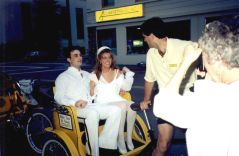
|
|
During the evening we all attended Toni and
Tina’s wedding. This turned out to be a real
laugh since not only did the priest get drunk
but many of the weird guests who were dressed in
outrageous clothes became involved in family
squabbles and even a fight. We were at a spoof
wedding, come dinner dance which was so well
done that it almost made us think it was the
real thing.
|
Saturday, 27 June 1998
We have now driven over 3,600 miles since we left Great Falls at the start of
our Alaskan trip, so it was time to service the RV while Valerie caught up on
the laundry. On talking to a local we were surprised to learn that every Alaskan
is given about $1,200 a year out of the oil profits by the tax man.
Sunday, 28 June 1998
We were not prepared for the spectacular fjord scenery which appeared soon after
we left Anchorage en route to Soldotna,
some 150 miles to the south. For the first few hours, the road followed the edge
of the Turnaround Arm of the
Cook Inlet where some white Beluga whales were
swimming close to shore. In several places, glaciers descended the mountains
ending in colourful lakes and along the roadside, mile after mile of blue
lupines were swaying in the light breeze. We stopped at
Portage to watch the unusual sight of a long flatbed train being loaded
with boats, cars, trucks and RVs and then pulling out of the station en route
for Whittier, where many take the ferry to
Valdez. As we approached Coopers Landing
we caught our first sight of the beautiful Kenai River
which is famous for its huge salmon runs. Numerous fishermen in waders were fly
fishing in the fast-flowing deep turquoise-blue water. Overhead several bald
eagles were circling, no doubt fishing for their salmon.
We decided to camp in the Fred Myers store parking lot where about a hundred
other RV’s were already parked, we were being watched by several moose from the
edge of the trees. The huge department store not only encourages RV’s with a
special parking area but also provides a dump for wastewater and a tap to fill
up freshwater tanks. We found Stirling and Vergie waiting for us when we
arrived. They had left us about a week earlier and driven ahead to ensure
Stirling was in time for the salmon run. He was excited as he had caught four.
Monday, 29 June 1998
A somewhat lazy day visiting the local area. The first stop was the visitor
centre which had masses of information and a nice display of the local wildlife.
The highlight was the world record 97 lb. King (Chinook) salmon was caught in
1984 in the local Kenai River. We spent some time during the afternoon
following the coast road and enjoying the panoramic view of the snow-covered
Chigmit Mountains which are dominated by
the still-active 10,000-foot Redoubt volcano.
Tuesday, 30 June 1998
After about 30 miles the route to Homer followed the
Cook Inlet, providing distant views of snow-covered mountains. As we
descended into Homer we had our first view of The
Spit, which is a narrow gravel bar some five miles long, extending out
into the Cook Inlet. We camped about halfway along The Spit at The
Fishing Hole, which is a large man-made tidal lake. Every year salmon are reared
in the lake, so providing fishermen with plenty to catch when they make their
annual return from the sea. Five eagles were patiently waiting for the next tide
to bring in another salmon run.
>>>
Home







